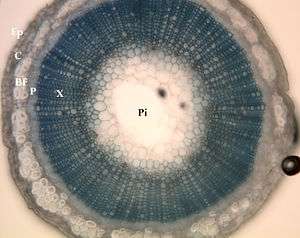Bast fibre
Bast fibre (also called phloem fibre or skin fibre) is plant fibre collected from the phloem (the "inner bark", sometimes called "skin") or bast surrounding the stem of certain dicotyledonous plants. They support the conductive cells of the phloem and provide strength to the stem. Some of the economically important bast fibres are obtained from herbs cultivated in agriculture, as for instance flax, hemp, or ramie, but also bast fibres from wild plants, as stinging nettle, and trees such as lime or linden, wisteria, and mulberry have been used in the past.[1] Bast fibres are classified as soft fibres, and are flexible.[2] Fibres from monocotyledonous plants, called "leaf fibre", are classified as hard fibres and are stiff.[2]
Since the valuable fibres are located in the phloem, they must often be separated from the xylem material ("woody core"), and sometimes also from the epidermis. The process for this is called retting, and can be performed by micro-organisms either on land (nowadays the most important) or in water, or by chemicals (for instance high pH and chelating agents) or by pectinolytic enzymes. In the phloem, bast fibres occur in bundles that are glued together by pectin and calcium ions. More intense retting separates the fibre bundles into elementary fibres, that can be several centimetres long. Often bast fibres have higher tensile strength than other kinds, and are used in high-quality textiles (sometimes in blends with cotton or synthetic fibres), ropes, yarn, paper, composite materials and burlap. An important property of bast fibres is that they contain a special structure, the fibre node, that represents a weak point, and gives flexibility. Seed hairs, such as cotton, do not have nodes.
Use of bast fibre
Examples are:
Bast fibres are processed for use in carpet, yarn, rope, geotextile (netting or matting), traditional carpets, hessian or burlap, paper, sacks, etc. Bast fibres are also used in the non-woven, moulding, and composite technology industries for the manufacturing of non-woven mats and carpets, composite boards as furniture materials, automobile door panels and headliners, etc. From prehistoric times through at least the early 20th century, bast shoes were woven from bast strips in the forest areas of Eastern Europe.
Where no other source of tanbark was available, bast has also been used for tanning leather.[3]
References
- ↑ Mary Dusenbury (1992), "A Wisteria Grain Bag And Other Tree Bast Fiber Textiles Of Japan", Textiles in Daily Life: Proceedings of the Third Biennial Symposium of the Textile Society of America, September 24–26 1992
- 1 2 Esau, K. (1977). Anatomy of seed plants. New York: John Wiley and Sons. ISBN 978-0-471-24520-9.
- ↑ "Production of Russia Leather" (PDF). The Honourable Cordwainers' Company. 1807. p. 2.
